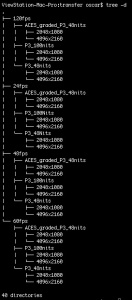After the exciting and eventful last week, this week has been very quiet and full of repetitive work. I have spent the week gathering all documents and files relating to the Next Generation Cinema Technology project and created records for them in an inventory spreadsheet. There ended up being just over one hundred records (including the large inventories of specific NGCT test shoot images as two separate individual records) specified in the inventory and heading to Norma for ingestion into the Science and Technology Council Archive.
Also this week, Mio has helped me transfer the actual NGCT image files from the server onto three hard drives. He wrote a shell script to carry out the transferring and check sums, which made the process quick and smooth. All 15 TB of the processed files took three days to transfer to the drives. We decided to make a copy of the raw files onto LTO-6 tapes which have a shelf life of 100 years. This was partly for ease of transition and partly to check that the Academy’s technology is working correctly.
Finally, I created two “readme” documents for the Science and Technology Council Archive and USC.The Sci-Tech readme explains the process I went through during my internship, the milestones, helpful points, and people I worked with. The USC document describes the file structures on each drive, the material on the LTO-6 tapes, and the other helpful documents I included with the drives.
With that, my internship is complete! Every day this summer I thought how lucky I’ve been to receive such an extraordinary opportunity. The project was perfect for my interests and future career, and even sparked more passion for film and film archiving than I had previously. I got to see the inner workings of an industry organization, rather than an academic organization, and found that I enjoy working for a non-profit organization. The Academy staff is fantastic, the building is beautiful, and Los Angeles has treated me well. I’m forever grateful for this internship and everything I will take with me!
